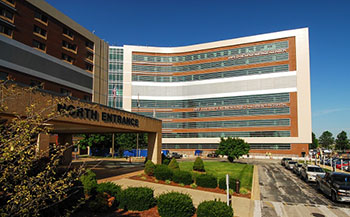 SPRINGFIELD, Mo. — CoxHealth’s Cox Medical Center South in Springfield recently completed a new West Tower addition, which houses the new Dee Ann White Women’s and Children’s hospital and the Jared Neuroscience Center.
SPRINGFIELD, Mo. — CoxHealth’s Cox Medical Center South in Springfield recently completed a new West Tower addition, which houses the new Dee Ann White Women’s and Children’s hospital and the Jared Neuroscience Center.
“The goal of the project was to move CoxHealth towards an all-private room model and provide space for future growth,” said Rod Schaffer, vice president, facilities management for CoxHealth.
The new, 10-story tower incorporates the CoxHealth design guiding principles: design for patient and family experience, for safety, for employer of choice and for stewardship. To those ends, the 343,000-square-foot tower includes 124 new beds — all of which are private rooms.
The tower’s ground floor is home to the 28-bed neonatal intensive care unit (NICU). A 26-bed pediatric unit is located on the building’s first floor. The second floor consists of a 32-private-room postpartum nursing unit and support spaces, featuring large rooms that allow babies to stay with moms and provide sufficient space for family visits. The third, fourth and fifth floors of the tower remain shell spaces to allow for future expansion. Floor six is mechanical, and floors seven, eight and nine are dedicated to the Jared Neuroscience Center.
“The change to all-private is most noticeable in the new NICU,” Schaffer said. “Where in the previous unit babies were housed in a ward with little privacy, each infant now has its own room where families can stay full time if so desired.”
Large playrooms and a private family lounge were constructed in the pediatrics unit and NICU, respectively, to give patients and families areas of respite during their stay. Three garden areas bordering the new addition provide opportunities for guests and staff to access the outdoors.
Through CoxHealth’s partnership with Children’s Miracle Network, Xbox units were provided in each pediatric patient room, and kid-centric design elements were incorporated on the pediatric floor. For safety, the bathrooms in the new tower are larger to enable caregivers to assist patients, and entry barriers have been eliminated to reduce fall risk. Plus, 25 percent of the rooms on the eighth-floor neurology floor have permanent patient lifts installed.
Bedside charting areas were provided in each patient room, and an additional charting station was provided directly outside of each NICU room with direct visibility to the patient. Decentralized nurses stations and duplicate medical and supply rooms keep providers closer to their patients and reduce travel times. Large classrooms and break rooms with windows to the outside were also included on each floor.
The new facility is designed — like all CoxHealth projects — to meet LEED Silver standards; however, certification was not pursued due to the extra cost for documentation and submission, according to Schaffer. Following LEED guidelines, ample natural light and energy saving building systems were included in the design. Demolition debris and construction waste were separated and recycled. Sustainable materials were also specified and used heavily in the new building. Additionally, more than 85 percent of the subcontractors on the project are based in Springfield and surrounding areas, continuing CoxHealth’s stewardship of the community it serves.
The hospital staff provided lots of feedback during the design phase, Schaffer said. After the initial user group meetings, an extensive mockup process was used to flesh out the patient rooms. One of each room type — NICU, PICU (prenatal intensive care unit) and surgery — was constructed in shell space off site where staff had the opportunity to walk through and locate light switches, headwall accessories and casework elements.
Dallas-headquartered Beck Group served as the architect on the project, while construction was managed in a joint venture between Beck Group and locally based Killian Construction Co. The project team brought the tower from conceptual design to occupied space in 26 months, according to Schaffer, and the structural phase went up during one of the worst Missouri winters in recent years. CoxHealth used the design-build contracting model on the project as well as other development on campus in recent years.
“Fast track design and construction has enabled our client to make decisions quickly and understand the budget and schedule ramifications of those decisions, enabling the team to bring the project in on time and under budget, while maximizing the value of the product delivered to the client,” Schaffer said.

